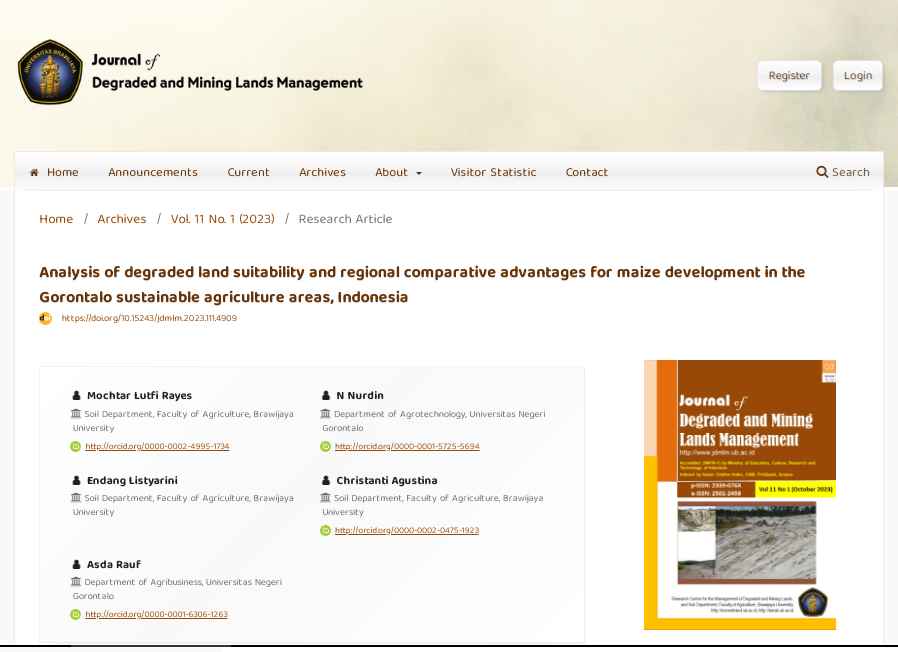Analysis of degraded land suitability and regional comparative advantages for maize development in the Gorontalo sustainable agriculture areas, Indonesia

Journal of Degraded and Mining Lands Management, Vol. 11 No. 1 (2023)
Mochtar Lutfi Rayes Soil Department, Faculty of Agriculture, Brawijaya Universityhttp://orcid.org/0000-0002-4995-1734
Nurdin Department of Agrotechnology, Universitas Negeri Gorontalohttp://orcid.org/0000-0001-5725-5694
Endang Listyarini Soil Department, Faculty of Agriculture, Brawijaya University
Christanti Agustina Soil Department, Faculty of Agriculture, Brawijaya Universityhttp://orcid.org/0000-0002-0475-1923
Asda Rauf Department of Agribusiness, Universitas Negeri Gorontalohttp://orcid.org/0000-0001-6306-1263
Abstract
Maize has attracted the attention of local governments due to its high yield potential and economic prospects, but the strategic value of this commodity has not been specific to particular locations. Therefore, this study aimed to assess degraded land suitability and determine the regional comparative advantages for maize development in the Gorontalo sustainable agriculture areas. The suitability class was assessed using Automatic Land Evaluation System software, while comparative advantages were determined using input-output and regional analysis. The input-output analysis was based on maize farming data from interviews with 80 farmers. This study also employed location quotient, specialization index, and localization index analyses based on maize, rice, and soybean production data for 2014, 2016, and 2018. The results showed that land degradation caused by soil erosion was dominated by moderate, heavy, and very heavy categories. Most of the actual land suitability for maize was classified as marginal suitable (S3) but became very suitable (S1) and moderately suitable (S2) after the limiting factors were improved. Furthermore, maize was profitable for the land suitability classes of S1, S2, and S3, and the commodity was most concentrated in Mootilango District. Based on the results, land management recommendations followed a pattern of recommendation I > II > III > not recommended.
Keywords:comparative advantagesland suitabilitymaize
Scopus Q3 dan Sinta 1: https://doi.org/10.15243/jdmlm.2023.111.4909
Kategori
- Abstract 2006
- Abstract 2009
- Abstract 2011
- Abstract 2012
- Abstract 2013
- Abstract 2014
- Abstract 2016
- Abstract 2018
- Abstract 2019
- Abstract 2020
- Abstract 2021
- Abstract 2022
- Abstract 2023
- Abstract 2024
- Abstract 2025
- Buku
- Kiprah Tugas Pembantuan ASN-Dosen
- Kunjungan Luar Negeri
- Mata Kuliah
- Pengukuhan Guru Besar, Prof. Dr. Nurdin, SP, MSi
- Project 2009
- Project 2010
- Project 2013
- Project 2018
- Project 2019
- Project 2020
- Project 2021
- Project 2022
- Publikasi Ilmiahku
- Soil Scientist from Gorontalo
Arsip
Blogroll
- a-SintaID
- b-Google Scholar
- c-Scopus ID
- d-Web of Science (WoS) ID
- e-ResearchGate
- f-Academia.edu
- g-SciProfiles
- h-Loop ID
- i-LinkedIn
- j-OrcidID
- k-figshare
- l-Youtube
- m-Twitter
- n-Facebook
- o-Universitas Negeri Gorontalo
- p-BIMA-Kemendikbud RI
- q-FAPERTA UNG
- r-LP2M UNG
- s- LP3M UNG
- t-SIMPPM UNG
- u-SIMLIT UNG
- v-Rispro LPDP
- w-BRIIN
- x-PDDIKTI
- y-GRS BPDPKS
- z-kampusmerdeka
- z1-ANJANI
- z10-SIAT UNG
- z11-Aplikasi SIAGA
- z12-SPADA Indonesia
- z13-SISTER
- z14-tesaurus.kemdikbud
- z15-UKBI
- z16-typoonline
- z17-Turnitin
- z18-Zetero
- z2-eHAKI
- z20-Himpunan Ilmu Tanah Indonesia(HITI)
- z21-BKN
- z21-Kementan RI
- z22-BPS Provinsi Gorontalo
- z23-BPS Kabupaten Boalemo
- z24-BPS Kabupaten Bone Bolango
- z25-BPS Kabupaten Gorontalo
- z26-BPS Kabupaten Gorontalo Utara
- z27-BPS Kabupaten Pohuwato
- z3-Arjuna
- z4-DIKTI
- z5-GARUDA Dikti
- z6-SIM Karier dan SDM Kemendikbud
- z7-KBBI
- z8-Kedaireka
- z9-RAMA
